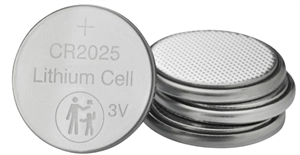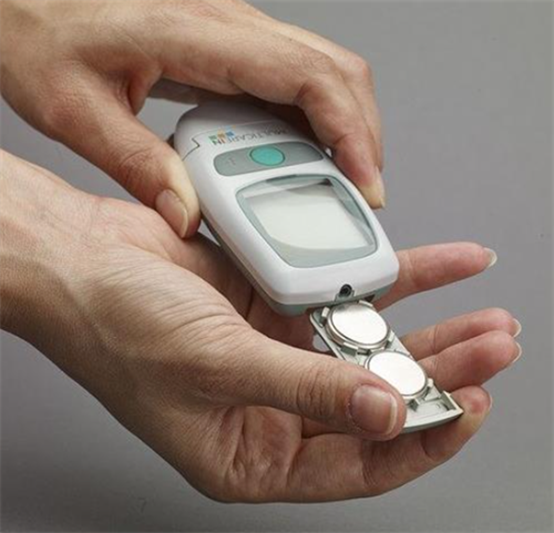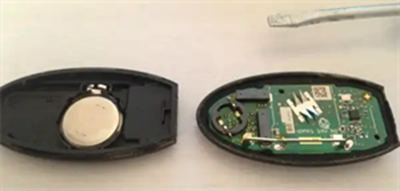CR2025 vs CR2016 Battery: Revealing the Secrets of Button Batteries
Small electronic devices frequently depend on the compact power of coin cell batteries for their efficient operation. Particularly, the CR2025 and CR2016 batteries stand out amidst the plethora of options, attracting attention for their broad applicability. Despite their outward resemblance, the disparity in thickness between them plays a pivotal role in their performance characteristics. Selecting the appropriate battery is not merely a matter of form but a crucial decision to guarantee the smooth functioning of your device.
Catalog

Figure 1: CR2025 VS. CR2016 Battery
Delving Into Lithium Coin Batteries
At the heart of the impressive energy density of lithium button batteries lies lithium itself—a lightweight metal renowned for its ability to deliver robust voltage and current in electrochemical exchanges. Take the CR2025 battery, for instance: its cathode is crafted from lithium compounds, contrasted by a carbon-based anode, often graphite. During discharge, lithium ions begin to move, moving from the cathode to the anode and back during charging. This movement of ions energizes the battery.
- CR2025 Battery Diameter: 20mm
- Thickness: 2.5mm
The genius behind their petite stature—a mere 20mm in diameter and 2.5mm thick—stems from an ingenious arrangement of internal components and the judicious choice of materials. Such a streamlined design renders these batteries perfect for devices where space is at a premium, such as hearing aids and diminutive remote controls.
When it comes to longevity on the shelf, these batteries stand the test of time, owing to a combination of advanced sealing techniques and inherent chemical stability crafted during their creation. The slow march of self-discharge, under 1% per annum, is a testament to the stability of their lithium compounds and the electrolyte's careful selection. Superior sealing wards off the encroachments of moisture and other external threats, safeguarding the battery’s vigor during prolonged storage.
- Self-Discharge Rate: Less than 1% annually
Venturing into the realm of temperature resilience, lithium button batteries boast a formidable operating range from the chills of -20°C to the swelter of +60°C. This versatility springs from a meticulously formulated electrolyte, ensuring consistent electrical flow and chemical equilibrium across a spectrum of climates. This adaptability ensures that whether in the grip of a frost or the blaze of a desert, these batteries deliver unwavering performance, making them indispensable in gadgets prone to facing the elements, from wilderness tech to vehicular trackers.
- Operating Temperature Range: -20°C to +60°C
In applications like smart thermometers, which navigate the flux of indoor warmth, the chill of the outdoors, and the cool of refrigerated spaces, the attributes of lithium coin batteries—high energy density, minimal self-discharge, and broad temperature tolerance—are nothing short of vital. They not only promise enduring power but also guarantee consistent function amidst fluctuating temperatures, ensuring the thermometer's precision remains unblemished. Thanks to their internal architecture, these batteries are a cornerstone in the realm of portable electronics, especially where compactness, efficiency, and resilience are non-negotiable.

Figure 2: Battery Composition
CR2025 and CR2016: Basic Overview
Among the small electronic devices commonly seen in our daily lives, CR2025 and CR2016 lithium coin cells stand out as key components. These batteries, emblematic of innovation and meticulous engineering, underpin the seamless operation of an array of gadgets. Delving into their characteristics reveals a tapestry of advantages and constraints tailored to diverse gadgetry needs.
- Chemistry: Lithium (Anode Material), Manganese Dioxide (Cathode Material)
- Diameter: 20mm
- Thickness: CR2025 - 2.5mm, CR2016 - 1.6mm
The designation "CR" in their names is a nod to their core composition—lithium ("C") and their circular ("R") form factor. The essence of their power lies in lithium chemistry. The movement of lithium ions through the electrolyte from the anode to the cathode, their movement based on the frequency of electron release. This efficient movement gives these batteries extremely high energy density.
- CR2025 Capacity: Higher, suitable for medical devices, high-performance remotes
- CR2016 Capacity: Lower, ideal for compact, space-sensitive applications like slim watches
Both models share a uniform 20mm diameter, yet it's in their thickness that their destinies diverge. The CR2025's robust 2.5mm profile harbors a larger energy reserve, making it the battery of choice for devices demanding longevity in their electronic heartbeat—think medical monitors or remotes that must endure. The CR2016, slender at just 1.6mm, slips into the slimmest of spaces, powering the elegance of modern wristwatches and other svelte devices.
Temperature variances play the puppeteer with lithium-ion batteries, their performance ebbing and flowing with the mercury. Cold climes can slow the lithium ions' pace, a sluggishness that reflects in the device's performance. Yet, it's not just the chill that poses a challenge; how these batteries are stored weaves into their tale of endurance. Proper storage thwarts the stealthy creep of self-discharge, ensuring the battery's vigor is preserved through the sands of time.
- Environmental Factors: Temperature sensitivity, storage conditions
The seals that protect the battery core and its electrode structure ensure the reliability and safety of the battery. A seal of high caliber rebuffs moisture and the myriad of elements that assail a battery's integrity. Meanwhile, the electrode's design ensures a stable and efficient discharge, a silent yet critical determinant of the battery's performance. CR2025 and CR2016 batteries, through their blend of energy density, adaptability in size, and resilience to environmental whims, have cemented their role in small electronic devices.

Figure 3: CR2025 Battery
Common Traits of CR2025 and CR2016 Batteries
At the core of the widespread adoption of CR2025 and CR2016 batteries lies their lithium-based design. This design ensures a consistent 3V nominal voltage that remains stable throughout the battery's lifespan. A closer look at these similarities reveals the essence of their crucial role in powering a plethora of modern electronic devices.
- Chemistry: Lithium
- Nominal Voltage: 3V
Lithium's exceptional electrochemical activity is what powers the remarkable performance of CR2025 and CR2016 batteries. This element's capacity to deliver substantial electrical energy from a compact form factor elevates these batteries' energy density well above that of traditional alkaline counterparts. Consequently, they offer a more potent energy reserve in a diminished space—a feature indispensable to the sleek electronic gadgets of our times, ranging from wearable tech to critical medical monitoring tools.
The choice of a 3V nominal voltage aligns perfectly with the electrical demands of various small electronics. Devices such as timers, calculators, and wristwatches benefit from this voltage standard, ensuring these batteries' widespread applicability across a multitude of gadgets. This universality means CR2025 and CR2016 seamlessly integrate into numerous devices without the need for specialized battery variants.
Regarding voltage stability, CR2025 and CR2016 stand out remarkably. They deliver unwavering voltage from the first use to the tail end of their lifecycle—an attribute paramount for precision devices. For high-precision instruments like top-tier micro-earphones, any fluctuation in power supply could compromise performance. The stable power output of these batteries, therefore, guarantees consistent functionality of such sensitive devices over time.
Moreover, lithium batteries boast a low self-discharge rate alongside an extended shelf life, enabling them to retain optimal performance even after prolonged storage periods. This trait is especially beneficial for seldom-used but always-ready devices, like emergency backup systems.
Distinguishing Factors: CR2025 vs. CR2016 Battery
Diving into the distinctions between CR2025 and CR2016, it becomes apparent that the thickness and capacity of these batteries mark the primary differences.
- CR2025 Thickness: More
- CR2016 Thickness: Less
- Capacity Difference: CR2025 > CR2016
CR2025's thicker design affords it a greater capacity, a feature that becomes pivotal in applications requiring sustained power delivery. Remote control devices, for instance, often favor CR2025 for its enduring energy supply. Conversely, CR2016's slimmer profile limits its capacity but unveils its strength in applications where space is at a premium. The elegance of certain women's watches, for example, owes much to the slimness of CR2016, which supports their sophisticated design without compromising on power reliability.
By juxtaposing these batteries, we uncover the nuanced balance between form factor and energy capacity that guides the selection process for various applications. Whether it's the longevity offered by CR2025 or the compact efficiency of CR2016, each battery finds its niche, powering the electronic marvels of our daily lives.
Deep Dive Into the CR2025 Battery
Delving into the world of the CR2025 battery uncovers a realm of intriguing specifics that underscore its suitability for an array of devices. Nestled within its compact form—20mm across and just 2.5mm thick—the CR2025 houses a nominal capacity of roughly 165mAh.
- Diameter: 20mm
- Thickness: 2.5mm
- Capacity: 165mAh
Assuming the battery powers a device that draws only 5mA, it has over 33 hours of continuous operation. Consider the smart health bracelet, tirelessly gathering your vital statistics while ensuring constant communication with your mobile through Bluetooth. Here, the CR2025's capacity and longevity are perfectly harnessed, catering to gadgets with a slightly voracious energy appetite.
- Current requirement: 5mA
- Operation time: >33 hours
CR2025's versatility doesn't end here. Its utility spans car remote keys, calculators, children's playthings, digital thermometers, and even the meticulous mechanisms of precision watches. Venturing beyond, the medical sphere, such as in blood glucose monitors, the CR2025's stable and enduring power becomes indispensable for managing health, thereby elevating user convenience and satisfaction by minimizing the frequency of battery replacements.
A Closer Look at the CR2016 Battery
With a solid grasp on the CR2025, our gaze shifts to its compact sibling, the CR2016, which unveils its unique attributes worth delving into.
- Diameter: 20mm
- Thickness: 1.6mm
- Capacity: 90mAh

Figure 4: Specification of CR2025 Battery
Slightly smaller, with a 1.6mm profile, the CR2016 packs a nominal capacity of about 90mAh. This translates to an 18-hour run time for devices consuming 5mA, though not as enduring as the CR2025, it adeptly supports a day’s usage for certain applications. This positions the CR2016 as a go-to for gadgets with minimal power demands, ensuring they remain both nimble and portable.
- Current requirement: 5mA
- Operation time: ~18 hours
The thin and light CR2016 finds its place in a range of small electronic devices. Take the automotive industry, where the sleek form of car remote keys often harbors the CR2016, chosen for both its compact size and sufficient daily energy provision. Notably, some high-end car models favor the CR2016 for their remote keys, a choice driven by space efficiency and modest power needs. Moreover, petite health trackers like pedometers also prefer the CR2016, prioritizing compactness and endurance over high-capacity energy solutions.

Figure 5: Application of CR2025 Battery In Blood Glucose Tester
CR2016 vs. CR2025: Comparison of Charging Capabilities
The CR2016 and CR2025 batteries mirror each other closely, presenting a facade of similarity that belies the nuances beneath. This deceptive resemblance might lead one to overlook the significant disparities in their charging capabilities.
- Battery Type: Non-rechargeable
- CR2016: Non-rechargeable
- CR2025: Non-rechargeable

Figure 6: Specification of CR2016 Battery
Despite their design as single-use batteries, destined for disposal post-depletion, an intriguing deviation has emerged. The market introduces devices claiming the ability to rejuvenate these batteries, a concept seemingly at odds with their foundational design. This practice, while controversial and potentially fraught with safety risks, hints at an underexplored facet of battery utility.
- Charging Potential
- CR2025: Superior charging potential due to larger capacity
- CR2016: Lesser charging potential
The larger capacity of the CR2025 battery positions it as the more viable candidate for charging attempts, albeit unorthodox. Consider the scenario of outdoor aficionados, who, driven by necessity, might resort to emergency charging a CR2025 within their flashlights. This effort to prolong illumination during nocturnal hikes or in the wilderness underlines the CR2025's adaptability in scenarios straying from conventional use.
- Practical Advice
Nevertheless, it's paramount to acknowledge the manufacturers' stance: such practices are not endorsed. The risks to safety and the potential compromise to battery integrity suggest adherence to official usage guidelines is prudent.
In summary, while the CR2025 shows a tantalizing glimpse into charging potential beyond its intended use, caution and respect for manufacturer guidelines should steer our practices. This exploration into the charging capabilities of CR2016 and CR2025 batteries reveals a landscape where necessity might inspire unconventional use, yet underscores the importance of adherence to safety and intended design.

Figure 7: Application of CR2016 Battery In Automotive Remote Controls
CR2016 vs. CR2025 Battery: Alternative Battery Options
Choosing the right battery can sometimes be flexible.
The CR2025 and CR2016 coin cells stand testament to this adaptability, hinting at a broader spectrum of interchangeable battery options.
- Key Considerations for Replacement:
- Chemistry
- Voltage
- Physical dimensions (Thickness and Diameter)
The market is awash with brands offering counterparts to these batteries, each promising compatibility and performance akin to the originals. For those leaning towards the CR2025, alternatives abound. Brands like Duracell, Energizer, Kodak, Maxell, Rayovac, and Sony proffer their versions, such as the DL2025 and ECR2025. These variants mirror the CR2025 in chemical makeup and electrical prowess, ensuring a seamless transition across devices.
CR2025 Alternatives
- Duracell's DL2025
- Energizer's ECR2025
- Other brands: Kodak, Maxell, Rayovac, Sony
Similarly, the search for substitutes for the CR2016 battery unveils a palette of equivalent choices. Duracell’s DL2016, and Energizer’s ECR2016, alongside offerings from Kodak, Maxell, Rayovac, and Sony, present viable alternatives. These replacements, tailored to match the voltage and dimensions of the CR2016, ensure the uninterrupted functionality of devices ranging from remote controls to small medical equipment.
CR2016 Alternatives
- Duracell's DL2016
- Energizer's ECR2016
- Other brands: Kodak, Maxell, Rayovac, Sony
When the journey for a substitute battery begins, it’s crucial to align the chosen battery’s specifications with those of the original, safeguarding the device from potential harm. This plethora of equivalent batteries not only broadens the horizons of choice but also simplifies the upkeep and substitution of batteries, weaving convenience into the fabric of battery maintenance.
Are CR2016 and CR2025 Batteries Interchangeable?
From a voltage perspective, one might think that the CR2016 and CR2025 batteries are brother models, with both having a nominal voltage of 3V. This similarity suggests they could be swapped with ease, assuming the device only cares about the voltage.
- Nominal Voltage: 3V
However, delving into the practical side reveals a different situation. Devices are often picky, designed with a particular battery model in mind to guarantee a snug and secure connection. Using a battery that doesn't quite fit could lead to a loose connection or, worse, not fitting at all. If trying to install a CR2016 in a space that requires a slightly thicker CR2025. The result? A battery that wobbles, risking the device's smooth operation. The reverse—stuffing a CR2025 into a slot meant for a CR2016—could spell disaster for the battery compartment.
- CR2016: Thinner, risk of loose fit
- CR2025: Thicker, potential for damage in a CR2016 slot
Thus, despite their voltage compatibility, mixing and matching CR2016 and CR2025 is frowned upon, considering capacity, physical dimensions, and the design specifics of the device.
CR2025 vs. CR2016: Which One to Choose?
When it comes to selecting between a CR2025 and a CR2016, consider it a dance of three factors: the device's power needs, its design constraints, and the expected longevity of the battery.
- Equipment Requirements
- Life Expectancy
- Size Requirements
For gadgets with a voracious appetite for energy—think long-lasting remote controls or vital medical monitors—the CR2025 is the best choice, boasting a capacity of about 165mAh. It's built for the marathon, not the sprint.
- CR2025 Capacity: Approximately 165mAh
On the flip side, if your device is all about that slim, sleek look, requiring batteries as thin as Specific types of micro-sensors, the CR2016 is your go-to. It's the preferred choice for chic fashion watches or diminutive sensors that blend into the background.
Each battery has its realm where it shines. The choice between them should be informed by a careful consideration of your device's specific needs, ensuring that the battery not only fits but also delivers the expected performance.
Conclusion
In conclusion, the CR2025 and CR2016 batteries might look deceivingly similar; however, they diverge significantly in aspects such as capacity, voltage stability, and the range of devices they are compatible with. One uncovers that the selection of the appropriate battery hinges on the specific requirements of the device it is intended for. This includes considerations like the desired longevity of the power supply, spatial limitations within the device, and its energy demands. CR2025 batteries are the first choice for devices requiring durable power, while CR2016 excels in compact electronic devices. The process of choosing between these two batteries necessitates a thoughtful examination of these parameters to guarantee that your device functions at its peak capability. It's through a meticulous comparison that we aim to arm our readers with the knowledge to navigate this decision, ensuring an optimal selection between the CR2025 and CR2016 is made.